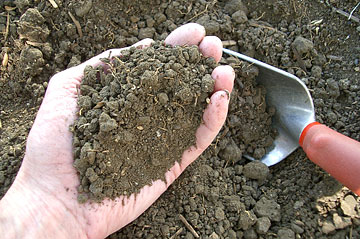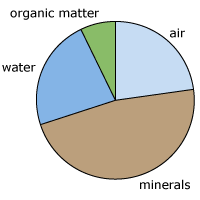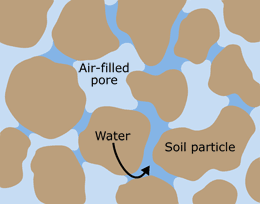- Home
- Learn about salinity
- Get to know your site
- Design a landscape
- Solve a problem
- Other information
Salinity Management Guide

Assessing the physical characteristics of soil
A soil's physical characteristics can greatly affect the movement of water through the soil and the accumulation of salt in the soil. In this section, several of those characteristics — texture, structure, degree of compaction, and layering — are examined and a number of tests you can use to assess the importance of each characteristic in terms of salinity are described.
Some of the tests outlined here are based on ones described in the Soil Quality Test Kit Guide, published by the U. S. Department of Agriculture's Natural Resources Conservation Service. That document is available online at http://soils.usda.gov/sqi/assessment/test_kit.html.

Texture defined

Most soil is composed of mineral matter, organic matter, water, and air. Usually, the mineral and organic matter exist mostly as particles, with the water and air existing in pores between the particles.
A soil's texture is determined by the coarseness or fineness of its particles.
Textures and corresponding sizes of particles
| Type of particle (texture) | Size in USDA System (mm) | Size in International System (mm) |
|---|---|---|
| Gravel | > 2.0 | — |
| Very coarse sand | 1.0 – 2.0 | — |
| Coarse sand | 0.5 – 1.0 | 0.2 – 2.0 |
| Medium sand | 0.25 – 0.5 | — |
| Fine sand | 0.1 – 0.25 | 0.02 – 0.2 |
| Very fine sand | 0.05 – 0.1 | — |
| Silt | 0.002 – 0.05 | 0.002 – 0.02 |
| Clay | < 0.002 | < 0.002 |
Adapted from Soil Sampling and Soil Description, by John M. Hodgson (Oxford Press, 1978).
A soil predominantly consisting of coarse textured sand contains relatively large void spaces, is well-aerated, drains freely, and dries out relatively quickly, as long as it isn't situated right above a layer of low permeability.
A soil consisting predominantly of fine-textured clay is often heavy and difficult to cultivate and tends to accumulate salts more readily. The presence of such a soil may adversely affect plants growing in the soil, particularly if water of moderate or high salinity is used for irrigation.
Various methods exist for assessing a soil's texture.
Structure defined
Sometimes confused with texture, structure refers to the way that particles of soil are grouped or aggregated together to create a system of large and small pores through which air and water flow. The resulting structural units may be granular, platy, blocky, prismatic, or columnar.
When a soil has a good structure, water is able to infiltrate it fairly readily. In fact, if a soil made up of 20% or more clay is well-structured, then water will infiltrate at a moderate rate instead of a very slow one.
Compaction, caused by compression of a soil, reduces the volume of the soil's pores. The compressive force often is foot traffic or vehicle traffic. Compacted soil is much less able to transmit water and air than is loose, uncompacted soil. The process occurs most readily, and its effects are most severe, when the soil is relatively wet. Various means are available to assess the degree of compaction of a soil.
Also, under certain circumstances, high concentrations of sodium ion in soil can cause the soil's structure to break down by chemical means, reducing the effective rates of infiltration and percolation.
Thickness and layering of soil defined
Thicker layers of permeable soil usually are advantageous for plants because they allow more water to infiltrate than do thin soils.
The thickness of a soil is essentially a measure of the distance from the soil's surface to a subsurface layer or zone that blocks the downward growth of plants' roots. This impervious subsurface layer or zone might be composed of bedrock, or of soil in which the air spaces have become filled with solid material. Often, the infilling material is clay, resulting in a feature of the soil known as a clay pan. In other cases, the infilling material is a cementing substance, such as precipitated calcium carbonate or magnesium carbonate, iron oxide, or aluminum oxide, and the feature that results is known as hardpan.
Various techniques can be used to assess the thickness and layering of soil.
| « Previous page | Next page » |